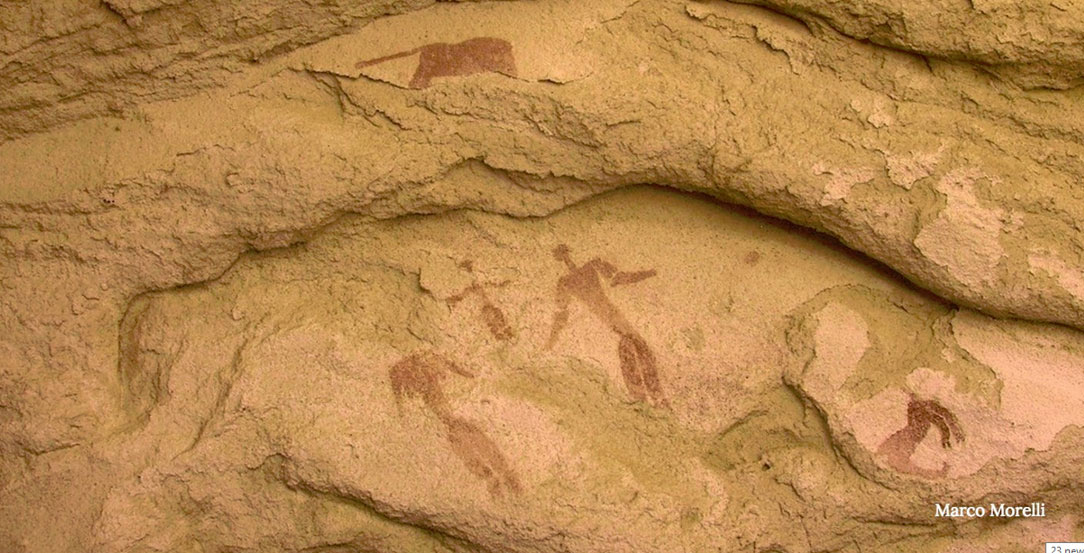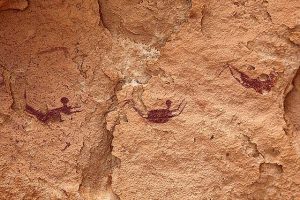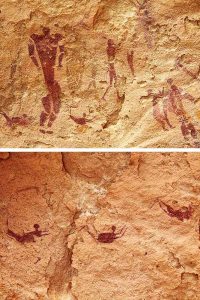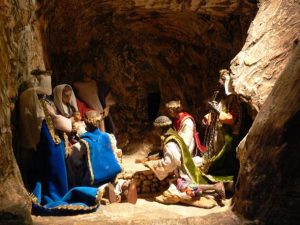3,000 Years Before the Birth of Jesus, a Nativity Scene Is Suggested by 5,000-Year-Old Rock Art

About 5,000 years ago an artist in Egypt painted an apparent nativity scene onto the rocks of a small cave—a tableau similar to crèche scenes that depict Jesus being laid in a manager in a cave or barn. The Egyptian scene, the oldest one known, includes two adults, a baby between them ascending, some animals and a dot above them and to the right, possibly indicating a star in the east.
The Italian researcher who discovered the scene kept it a secret when he found it in 2005, said a story about the find on Seeker.com. It is the oldest known nativity scene in the world – the word nativity means birth – and the researchers named it ‘The Cave of the Parents’.
Although there is not too much more information to be found about the depiction, and even now the original report on Seeker is illusive, the reported find is certainly a curiosity.

An Ox, an Ass … a Dragon? Sorry, there were no Animals in the Bible’s Nativity Scene
Nativity Scene Hidden Under Baptist Beheading Painting
Ancient Nativity Scene Discovery: A 3,000-Year Prelude
“It’s a very evocative scene which indeed resembles the Christmas nativity. But it predates it by some 3,000 years,” geologist Marco Morelli, who discovered the painting, told Seeker.com at the time. In 2016, he was the director of the Museum of Planetary Sciences in Prato, Italy.

“The discovery has several implications as it raises new questions on the iconography of one of the more powerful Christian symbols.”
Nativity scenes celebrating Christ’s birth are shown in modern churches, miniature ones in people’s homes and larger scenes on people’s lawns in front of their homes or in other public places. Some live nativity scenes even include livestock and real humans posing as the family of Jesus, Mary and Joseph.
Christmas hymns have celebrated the nativity scene, including the song Away in a Manger, the first verse of which says:
Away in a manger, no crib for a bed,
The little Lord Jesus laid down his sweet head,
The stars in the bright sky looked down where he lay,
The little Lord Jesus asleep on the hay.
The Gospel of Luke’s second chapter gives details concerning the birth of Jesus and how his father and mother were turned away from the inns in Bethlehem because the inns were full and had to take refuge in either a barn or a cave, where the Bible says Mary gave birth to Jesus.

Millennia after this prehistoric Egyptian nativity scene was painted, Christians celebrate Christ’s birth with scenes and tableaus of Mary and Joseph, the newborn, shepherds, the three wise men and farm animals. (Public Domain)
Symbolism in the Rock Art: Birth, Death, and the Sky
It’s interesting to note that after Jesus’ birth his mother and father fled for refuge to Egypt after Herod ordered all males under age 2 in Bethlehem slain. This rock art, announced in 2016, was in Egypt. The story of the flight to Egypt is recounted in Matthew, Chapter 2.
Dr. Morelli discovered this painting in the Sahara Desert, between the Nile Valley and the Gilf Kebir plateau, Seeker.com said.
The head of the woman in the painting is missing, the rocks upon which it was painted apparently having become detached.
Dr. Morelli told Seeker.com that it could be just a depiction of a mundane family, but details pointed to special significance. The baby is drawn above the parents and appears to be traveling toward the heavens. Dr. Morelli said this indicates a pregnancy or birth.
He continued to explain, in rock art in that part of the world at that time, death corresponded to earth. He draws the conclusion that birth may have been associated with sky.
Political Landscape of the Nativity of Jesus
What the Magi Had in Common with Scientists
The symbology of the animals and the small circle to the east indicate a special significance. The artist painted a mythical headless lion above the apparent parents. Headless lions were mythical in the Neolithic or New Stone Age in that part of the world. One of Jesus’ titles is the Lion of Judah. Below the parents and baby is some type of anthropomorphic monkey or baboon.
Dr. Morelli held such imagery was thought to have dated solely from the early Christian era and thereafter, but this particular nativity predates that by a thousand years. Well, of course, babies were being born before Jesus.